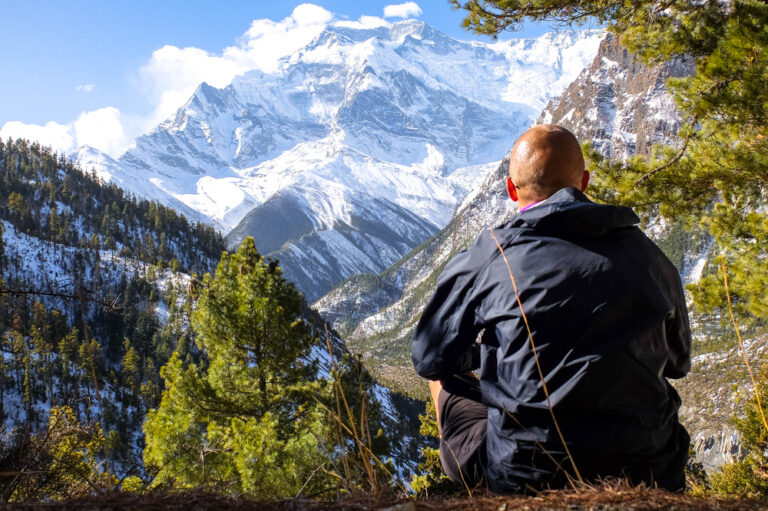Trekking the Annapurna Circuit is renowned for its unmatched beauty and cultural diversity. This well-known hike around the magnificent Annapurna Massif provides a fascinating tour through various scenic areas and quaint towns. In this article, we shall go into great detail on the difficulty of the Annapurna Circuit hike.
Annapurna Circuit Trek: An Overview
The trek progresses through lush subtropical forests, terraced fields, and high alpine meadows. Villages along the way allow you to familiarize yourself with the Gurung, Manangi, and Thakali communities. The challenging ascent to Thorong La Pass, at 5,416 meters, rewards trekkers with panoramic views of the Annapurna and Dhaulagiri ranges. All in all, the Annapurna Circuit promises stunning vistas and cultural immersion. However, understanding the trek’s difficulty is crucial for a successful and enjoyable experience.
There is no trail more popular than the Annapurna Circuit. Its widespread praise is due to its perfect combination of breathtaking scenery with genuine cultural elements. Because of this, it is suitable for both experienced travellers and those taking on their first Himalayan expedition.
Factors Influencing Difficulty
Altitude
One of the challenges faced by trekkers attempting the Annapurna Circuit is altitude. The journey begins in subtropical areas and advances quickly, topping 5,416 meters at Thorong La High Pass. The trail climbs to heights across various elevations, but the thinner air is a significant challenge.
Altitude-related difficulties can arise for hikers, highlighting the significance of acclimatization techniques and risk awareness. Because of the different heights along the Annapurna Circuit trip, altitude is a defining aspect of the complex nature of the journey, necessitating careful planning and preparation.
Terrain
The Annapurna Circuit Trek is difficult in part because of the varied landscapes it passes over. Trekkers travel through various environments, including rough mountain routes, terraced farmland, and beautiful forests. Every terrain has its difficulties that call for flexibility and physical effort. Due to the constantly shifting topography, trekkers must navigate uneven pathways and steep ascents and descents, which increases the trip’s difficulty overall. The Annapurna Circuit’s varied and somewhat unpredictable terrain means that hikers must be well-prepared for a challenging and rewarding experience.
Duration
Trekkers may find the length of the Annapurna Circuit trek to be complicated. The journey, which spans roughly 160–260 km, takes a significant amount of time—10–21 days, at minimum. The longer time frame presents issues with both mental and physical endurance. Trekkers need to be well-rested, have steady energy levels, and plan their rest days to help with acclimatization. The trek’s length adds a further element of complexity, highlighting the importance of careful planning and the capacity to maintain both physical and emotional resilience during the route. The lengths of several trek packages for the Annapurna Circuit are listed here.
12 Days Annapurna Circuit Trek
14 Days Annapurna Circuit Trek
15 Days Annapurna Circuit Trek
Short Annapurna Circuit Trek
Physical Fitness Requirements
The Annapurna Circuit hike also requires a certain level of physical fitness. Trekkers must be physically fit because of the rugged terrain, high elevations, and prolonged length. Strength, general fitness, and cardiovascular endurance are required for the trek. Pre-trek training, including hiking, weight training, and cardiovascular exercises, becomes crucial for trekkers to complete the circuit’s physical demands effectively. Physical fitness significantly influences the overall difficulty of the Annapurna Circuit walk, highlighting the significance of sufficient preparation.
Mental Preparedness
Being mentally prepared is just as important as being physically fit. Trekkers need to be prepared for trekking in isolated areas, be able to adjust to unforeseen circumstances, and deal with variable weather. Engaging in mindfulness exercises and cultivating a positive mindset can make trekking more fulfilling.
Here is how to prepare to face this trek.
Physical preparedness
Those can finish this trek with an average fitness level and a good dose of willpower. You should know that you will appreciate the walk more if you are in better shape. Therefore, we recommend engaging in activities that increase stamina, such as cycling, swimming, or jogging, a few weeks before beginning the Annapurna Circuit trek. You can include exercises like planks, lunges, and squats in your fitness routine to strengthen your body.
Choose the right trek package.
The choice of route can affect the Annapurna Circuit’s level of difficulty. Thus, consider your tastes, preferences, and physical condition when selecting the finest trek package. The walk can be finished in ten days or extended to last almost a month.
Purchasing travel insurance
The high-altitude Annapurna Circuit Trek takes you to isolated areas of western Nepal. Because these places lack sufficient treatment facilities, you must get travel insurance that covers helicopter evacuation up to the highest hike altitude.
Dietary and lodging considerations
Despite the trek’s isolated location, tea houses and hotels are in the appropriate places, so you should be reassured about running out of food. You won’t, however, have the same options that large cities have. Furthermore, as the meat in the hike zones might not be hygienic, we urge you to limit your diet to non-vegetarian options. Similarly, all you’ll get are nice but possibly small lodgings. Most of the rooms will be shared by twins.
To sum up, the degree of difficulty of the Annapurna Circuit hike primarily depends on your tastes, level of fitness, and preparedness. Therefore, we advise you to evaluate your fitness level, prepare, and set reasonable expectations before the adventure. Adequate planning is essential to experiencing this fantastic adventure.
Read More: How to Find the Best Attorney for Personal Injury?.

